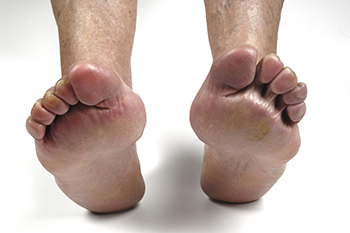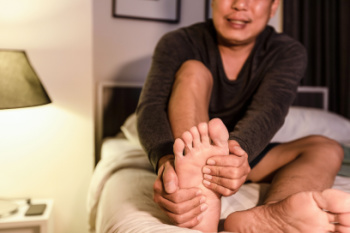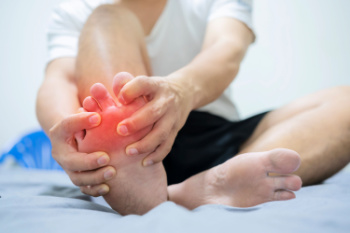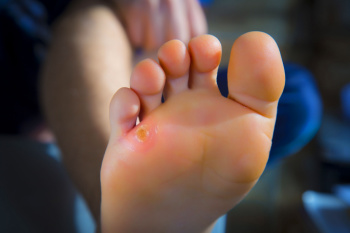Items filtered by date: August 2025
Rheumatoid Arthritis and Its Impact on Feet and Ankles

Rheumatoid arthritis is an autoimmune condition that can cause inflammation, stiffness, and joint damage in many parts of the body, including the feet and ankles. In these areas, the disease often leads to swelling, tenderness, and reduced mobility, making walking and daily activities more challenging. Over time, joint structures may change shape, causing deformities such as bunions, hammertoes, or collapsed arches. These changes can alter the way weight is distributed across the feet, increasing discomfort and the risk of additional problems. Podiatrists play an important role in managing these symptoms by recommending supportive footwear, orthotics, exercises, and, in some cases, discussing surgical options. Addressing issues early can help preserve mobility and reduce pain. If you have rheumatoid arthritis and notice increasing discomfort or changes in your feet or ankles, it is suggested that you consult a podiatrist for relief and management tips.
Because RA affects more than just your joints, including the joints in your feet and ankles, it is important to seek early diagnosis from your podiatrist if you feel like the pain in your feet might be caused by RA. For more information, contact Kenneth Williams, DPM of Texas. Our doctor will assist you with all of your podiatric concerns.
What Is Rheumatoid Arthritis?
Rheumatoid Arthritis (RA) is an autoimmune disorder in which the body’s own immune system attacks the membranes surrounding the joints. Inflammation of the lining and eventually the destruction of the joint’s cartilage and bone occur, causing severe pain and immobility.
Rheumatoid Arthritis of the Feet
Although RA usually attacks multiple bones and joints throughout the entire body, almost 90 percent of cases result in pain in the foot or ankle area.
Symptoms
- Swelling and pain in the feet
- Stiffness in the feet
- Pain on the ball or sole of feet
- Joint shift and deformation
Diagnosis
Quick diagnosis of RA in the feet is important so that the podiatrist can treat the area effectively. Your doctor will ask you about your medical history, occupation, and lifestyle to determine the origin of the condition. Rheumatoid Factor tests help to determine if someone is affected by the disease.
If you have any questions, please feel free to contact our office located in San Antonio and Beeville, TX . We offer the newest diagnostic and treatment technologies for all your foot care needs.
Neuropathy and Its Impact on Foot Health

Neuropathy is a condition where the nerves are damaged or not functioning properly, often affecting the feet. This can lead to neuralgia, which is sharp, burning nerve pain, or cause numbness, tingling, and loss of sensation. Feet may feel weak or overly sensitive. Risk factors of neuropathy include diabetes, alcohol use, infections, and certain medications. These symptoms can increase the risk of injury, infection, and balance issues. A podiatrist can help by identifying the type and cause of neuropathy and offering treatment to manage symptoms, protect the feet, and improve quality of life. If you notice unusual sensations or pain in your feet, it is suggested that you contact a podiatrist to begin proper care and prevent further complications.
Neuropathy
Neuropathy can be a potentially serious condition, especially if it is left undiagnosed. If you have any concerns that you may be experiencing nerve loss in your feet, consult with Kenneth Williams, DPM from Texas. Our doctor will assess your condition and provide you with quality foot and ankle treatment for neuropathy.
What Is Neuropathy?
Neuropathy is a condition that leads to damage to the nerves in the body. Peripheral neuropathy, or neuropathy that affects your peripheral nervous system, usually occurs in the feet. Neuropathy can be triggered by a number of different causes. Such causes include diabetes, infections, cancers, disorders, and toxic substances.
Symptoms of Neuropathy Include:
- Numbness
- Sensation loss
- Prickling and tingling sensations
- Throbbing, freezing, burning pains
- Muscle weakness
Those with diabetes are at serious risk due to being unable to feel an ulcer on their feet. Diabetics usually also suffer from poor blood circulation. This can lead to the wound not healing, infections occurring, and the limb may have to be amputated.
Treatment
To treat neuropathy in the foot, podiatrists will first diagnose the cause of the neuropathy. Figuring out the underlying cause of the neuropathy will allow the podiatrist to prescribe the best treatment, whether it be caused by diabetes, toxic substance exposure, infection, etc. If the nerve has not died, then it’s possible that sensation may be able to return to the foot.
Pain medication may be issued for pain. Electrical nerve stimulation can be used to stimulate nerves. If the neuropathy is caused from pressure on the nerves, then surgery may be necessary.
If you have any questions, please feel free to contact our office located in San Antonio and Beeville, TX . We offer the newest diagnostic and treatment technologies for all your foot care needs.
Toe Pain May Indicate Other Issues

Toe pain, which can range from mild discomfort to severe irritation, often signals an underlying issue. Common causes include bunions, which show as a bony bump on the side of the foot, and ingrown toenails that pierce the surrounding skin. Morton’s neuroma can cause sharp, burning pain between the toes, while gout results in sudden joint inflammation and swelling. Additionally, cellulitis, a serious skin infection, can also lead to pain and redness. A podiatrist can diagnose the cause, provide treatments such as medications, orthotics, or minor procedures, and help prevent complications. Ignoring toe pain can affect mobility and overall foot health. If you are experiencing toe pain, it is suggested that you schedule an appointment with a podiatrist who can provide an accurate diagnosis and treatment.
Toe pain can disrupt your daily activities. If you have any concerns, contact Kenneth Williams, DPM of Texas. Our doctor can provide the care you need to keep you pain-free and on your feet.
What Causes Toe Pain?
Most severe toe pain is caused due to a sports injury, trauma from dropping something heavy on the toe, or bumping into something rigid. Other problems can develop over time for various reasons.
Toe pain can be caused by one or more ailments. The most common include:
- Trauma
- Sports injury
- Wearing shoes that are too tight
- Arthritis
- Gout
- Corns and calluses
- Hammertoe
- Bunions
- Blisters
- Ingrown toenails
- Sprains
- Fractures (broken bones)
- Dislocations
When to See a Podiatrist
- Severe pain
- Persistent pain that lasts more than a week
- Signs of infection
- Continued swelling
- Pain that prevents walking
Diagnosis
In many cases the cause of toe pain is obvious, but in others, a podiatrist may want to use more advanced methods to determine the problem. These can range from simple visual inspections and sensation tests to X-rays and MRI scans. Prior medical history, family medical history, and any recent physical traumatic events will all be taken into consideration for a proper diagnosis.
Treatment
Treatments for toe pain and injuries vary and may include shoe inserts, padding, taping, medicines, injections, and in some cases, surgery. If you believe that you have broken a toe, please see a podiatrist as soon as possible.
If you have any questions please contact our office located in San Antonio and Beeville, TX . We offer the newest diagnostic and treatment technologies for all your foot and ankle needs.
Heel Pain Can Be Treated!
A Podiatrist Can Provide Relief for Corn Pain

Corns are thickened areas of skin that form in response to friction or pressure. Hard corns often appear on the tops of toes, the soles of the feet, or the side of the little toe, while soft corns usually develop between toes where the skin stays moist. These painful spots result from wearing tight shoes, abnormal toe positioning, or repeated rubbing against footwear. Over time, corns can make walking uncomfortable and lead to further complications. A podiatrist can accurately diagnose the type of corn, safely remove the thickened skin, and recommend methods to prevent recurrence. If you have a painful corn, it is suggested that you consult a podiatrist who can offer effective relief and treatment tips.
Corns can make walking very painful and should be treated immediately. If you have questions regarding your feet and ankles, contact Kenneth Williams, DPM of Texas. Our doctor will treat your foot and ankle needs.
Corns: What Are They? And How Do You Get Rid of Them?
Corns are thickened areas on the skin that can become painful. They are caused by excessive pressure and friction on the skin. Corns press into the deeper layers of the skin and are usually round in shape.
Ways to Prevent Corns
There are many ways to get rid of painful corns such as:
- Wearing properly fitting shoes that have been measured by a professional
- Wearing shoes that are not sharply pointed or have high heels
- Wearing only shoes that offer support
Treating Corns
Although most corns slowly disappear when the friction or pressure stops, this isn’t always the case. Consult with your podiatrist to determine the best treatment option for your case of corns.
If you have any questions, please feel free to contact our office located in San Antonio and Beeville, TX . We offer the newest diagnostic and treatment technologies for all your foot care needs.

